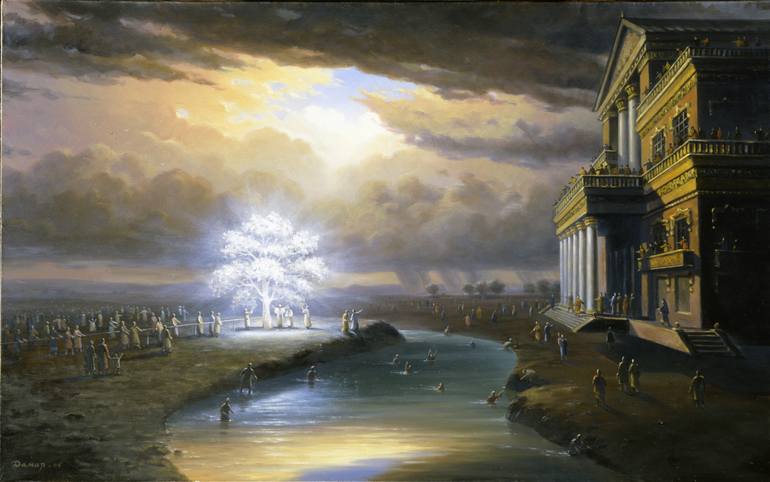Down through the ages, Father Lehi’s Tree of Life dream has continued to teach and warn all who will read and ponder it. I, for one, love this vision. Moreover, I deeply appreciate the many detailed artistic depictions of it. All Tree of Life paintings or drawings I have witnessed have something meaningful to offer.
Russian born artist, Damir Krivenko, painted Lehi’s vision this way:

I can’t speak for the artist, but I wonder if perhaps he wanted his portrayal to especially draw attention to the body of water that separated the tree of life (and the rod of iron leading to it) from the great and spacious building.
Of that body of water, Nephi told his brothers it represented “filthiness.” (1 Nephi 15:27) Further, he declared, “…it was an awful gulf…” (1 Nephi 15:28) Krivenko’s painting showcases a significant divide between the two sides, one that definitely offers a distinct message of disunion.
Just on the other side of the river is the great and spacious building.
In Lehi’s dream, he saw that “great was the multitude that did enter into that strange building.” (1 Nephi 8:33). In our day, I wonder how many people who try to navigate the river ever actually make it to the building. Since the river is filthiness, it goes without saying that all within it is likewise soiled and grimy. For the too many I have witnessed who have taken their hands off the iron rod and in Father Lehi’s words, “[wandered] in strange roads,” they seem to have been spiritually swallowed up or spiritually drowned in the river – even before they find the building (1Nephi 8:32).
In his own words, Lehi said:
“And I also cast my eyes round about, and beheld, on the other side of the river of water, a great and spacious building; and it stood as it were in the air, high above the earth. And it was filled with people, both old and young…” (1 Nephi 8: 26, 27)
Until today, I had imagined only one image for the great and spacious building, that foundationless structure.
After listening to our stake patriarch share some thoughts on this subject, I have come away with a new understanding. Patriarch said that in a recent patriarchal blessing he was pronouncing upon the head of a brother, he promised the receiver that his great and spacious building would, dependent upon the receiver’s righteousness and faithfulness, collapse. The patriarch said up until this point, he hadn’t realized the individualistic nature of the great and spacious building.
And neither had I.
Our patriarch said each of us has our own, as it were, great and spacious building. It is the thing that haunts or torments us the most, the vice that keeps pulling us down, the greatest of our temptations.
Nephi saw that Babylon’s great and spacious building collapsed.
Will ours?
“And it came to pass that I saw and bear record, that the great and spacious building…fell, and the fall thereof was exceedingly great…” (1 Nephi 11:36)
We know that the world, and all that makes it filthy, will fall in a coming day.
Until then, it seems beneficial to pause and consider what the great and spacious building looks like for each of us, for the one we see, and to ask ourselves how firmly it is standing and beckoning us towards its doors.
Unto all the world: Down with our great and spacious buildings!